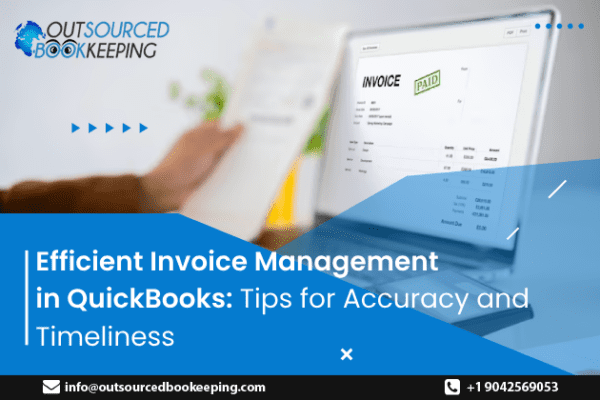One of the most significant elements of managing a successful business is effective invoice handling. Inaccurate or late bills can cause problems with cash flow, damaged client relationships, and administrative obstacles. Many companies use QuickBooks (Invoice Management in QuickBooks), a well-known accounting programme that provides an array of tools to simplify invoice administration, to address these issues.

Businesses can enhance accuracy, punctuality, and efficiency in QuickBooks invoice management by applying these tax planning tips for 2023. Effective invoice management is key to maintaining strong financial operations, whether you’re a small business owner, contractor, or financial professional.
Creating Professional and Customisable Invoices
A key component of effective invoice management in QuickBooks is the creation of professional, customisable invoices. Establishing confidence and professionalism with clients depends heavily on the accuracy and thoroughness of billing information. Businesses can customize QuickBooks invoices to reflect their brand and enhance professionalism.
With an array of customisation options offered by QuickBooks (Invoice Management in QuickBooks), businesses may add their logo, contact details, and branding components to the invoices. This promotes brand awareness and establishes a unified visual identity throughout all client interactions. Additionally, companies may add messages to bills to make them more distinctive, which helps develop connections with clients and increase customer satisfaction.
Additionally, QuickBooks offers customisation options for invoice templates, enabling companies to construct pre-defined designs that can be quickly utilised for regular customers or particular kinds of transactions. This reduces the need for manual modifications for each billing cycle and maintains uniformity in invoice layout. Businesses may project a positive image, enhance customer connections, and simplify tax planning by concentrating on producing competent and adaptable invoices in QuickBooks.
Implementing Efficient Follow-Up Practices
- Establishing clear communication channels for payment reminders is a crucial component of effective follow-up procedures. These channels should be used to give clients payment reminders. This can involve sending emails, making phone calls, or even sending messages. Businesses may ensure consistent and prompt contact with past-due bills by setting up specified channels.
- Automation is essential for optimising follow-up procedures. Businesses may automate reminders for past-due bills by utilising the automation features of accounting software like QuickBooks (Invoice Management in QuickBooks) . Customers may be promptly informed of unpaid invoices due to the scheduling flexibility of these reminders.
- Effective follow-up procedures go beyond merely reminding people to follow up. It entails taking proactive measures to quickly detect and address payment concerns. Track payment patterns, confirm terms with clients early, and resolve issues proactively.
- It’s critical to have escalation procedures in place for situations where consumers repeatedly refuse to pay. This may entail delivering official collection letters and working with collection agencies or attorneys. Businesses may make sure that they take the proper steps to safeguard their financial interests by putting escalation processes into place.
Businesses may increase their cash flow, lower their outstanding receivables, and preserve good customer relations by putting effective follow-up procedures in place. These procedures aid organisations in managing their accounts receivable, reducing payment delays, and ensuring prompt collections.
Streamlining Accounts Receivable Processes
Businesses perhaps must streamline their accounts receivable procedures if they want to maximise their financial operations and have a positive cash flow. By integrating QuickBooks with solutions for managing accounts receivable, data may be synchronised automatically, obviating the need for human data entry and minimising mistakes. Businesses may use this connection to automate the tracking and reconciliation of incoming payments.
Businesses may save time and money by automatically matching payments made with related invoices in QuickBooks. This also improves accuracy and lowers the possibility of missed or duplicate payments. Businesses may proactively manage any unpaid bills or late payments, boosting collections by tracking payment patterns, ageing invoices, and customer payment behaviours.
Effective accounting and handling of receivables help improve cash flow management and financial forecasts. Businesses may anticipate their cash flows, determine their demand for working capital, and determine their financial needs by using accurate, current receivables data and outsourced bookkeeping services. Businesses can project a positive image, strengthen customer ties, and simplify tax planning with professional, flexible QuickBooks invoices.
When it comes to selecting reliable bookkeeping services, Outsourced Bookkeeping is a company that ought to be given careful consideration. To satisfy the various demands of their clients, Outsourced Bookkeeping provides a wide range of services. Regardless of your business’s size, its team of qualified bookkeepers actively manages your financial tasks with precision and efficiency.








